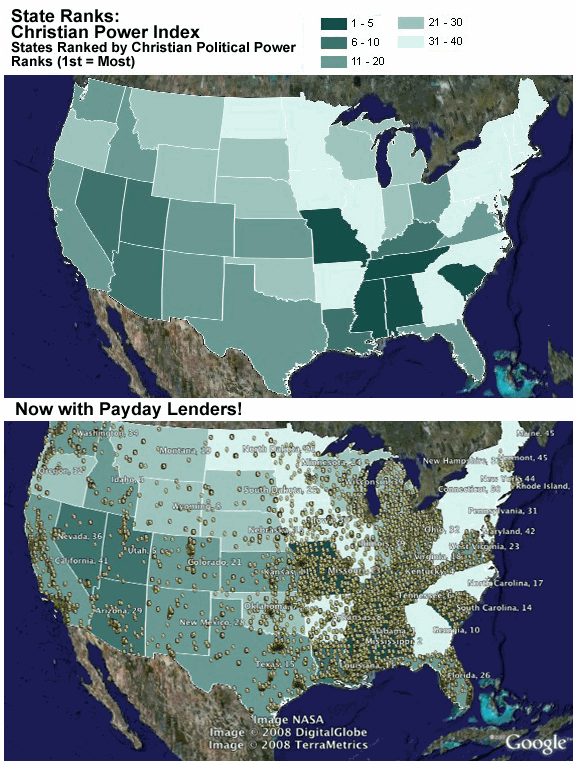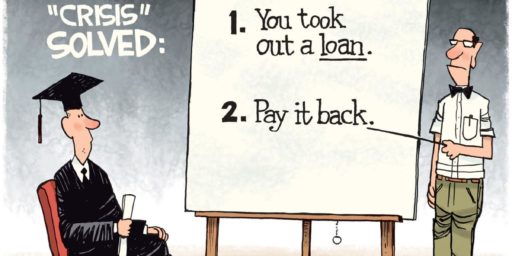Payday Lending
There are some signs that there is some interest in capping/curbing payday lending practices. The article paints a rather sad picture,
The Center for Responsible Lending, an anti-payday lender group, said Thursday that its nationwide study found that the typical payday borrower pays back $793 for a $325 loan. It says such data come from state regulators, public filings and assessments of industry analysts.
Going to the website for the Center for Responsible Lending we find even more disconcerting information,
Every year, payday lenders strip $4.2 billion in excessive fees from Americans who think they’re getting a two-week loan and end up trapped in debt. This report finds that across the nation payday borrowers are paying more in interest, at annual rates of 400 percent, than the amount of the loan they originally borrowed.
[snip]
Predatory payday lending now costs American families $4.2 billion per year in excessive fees.
States that ban payday lending save their citizens an estimated $1.4 billion in predatory payday lending fees every year.
And yes this looks pretty darned sad. People who are in financial problems turn to an industry that they think will help them, but in often times hurts them.
However, the idea of capping rates/fees and limiting the number of loans that people can apply for really don’t sound all that much like solutions too me. The detailed report by the Center for Responsible Lending has the following,
A borrower facing financial trouble will rarely be able to overcome it in a short period of time, such as the two-week term most often provided by payday lenders, and then immediately be in a position to pay back the loan in full. Most borrowers will need several months, perhaps a year, to have a legitimate opportunity to solve the problem.
But what is their solution? Limit the number of loans that people in such financial problems can obtain. Basically limit it to one loan every 90 days. While it solves the problem of churning loans, it doesn’t address the real issue that is causing these people to turn to payday loan companies in the first place. Putting caps on the interest rates/fees and/or limiting the number of loans one might get could actually lead to even worse problems.
Capping the interest rates/fees could result in the industry disappearing. Basically this is very much like George Akerlof’s lemon model. In Akerlof’s model there are two types of used cars, a “peach” and a “lemon”. Buyers are unaware of the car’s type, but the seller is aware of the car’s type. This is a simple case of assymetrical information. One side knows something that the other does not that affects the transaction. If there is no way for the buyer to learn the cars type, Akerlof showed that the only market that forms is the market with “lemons”. In this case, by capping the interest rates and hence industry profits firms might leave the industry to such an extent that it no longer exists. And at the very least it would induce some of the firms to leave the market which would make it harder for people in financial hardships to obtain this type of lending.
Similarly with the cap on the number of loans. A person might not be able to resolve their financial hardship within the 90 day period or with a single loan. What is the alternative? If the hardship is fixing a vehicle, then it is not fixing the vehicle. If that vehicle is necessary for the livelihood of the family?
Of course it is also quite possible that these regulations would make things better overall. The problem is that the kind of analysis necessary to make this determination has not been done, at least by the Center for Responsible Lending. The problem is that payday lending may be one of the few and possibly the only alternative for many borrowers in times of financial hardship. While regulations could make such borrowing harder to obtain it doesn’t deal with the financial hardship which is itself a cost.
In short, the research by the Center for Responsible Lending is…well half-assed. It very well could be that payday lending, in the end, is very bad and forcing people to simply suffer the financial hardship with few other options is the best course, but we can’t make that determination from this kind of “analysis”.






You also get the ‘unregulated’ interests coming into the market. It used to be called loan sharking. Your collateral was your knees (as in they will bend in a new direction if you don’t keep up at least the interest rates).
This is a little bit like the micro-economic small loan programs in third world countries. Another analogy was the impact of welfare on getting Appalachian families out of debt to the ‘company store’. To me the most promising way to break the cycle would be a charity loan program. Initial capital provided by charity donors. Payments set for a 6 month pay back (so the $325 loan would see pay back at $26.25 every two weeks (assuming 2 week pay period) for a total pay back of $341.25 (10% annual simple interest). Given the likely high bad debt ratio (people living hand to mouth at this level are more likely to have a sequence of events than those operating with a cushion), the loaning company would be lucky to break even after inflation and would have very little for administering the company. Which gets into why I think it would make most sense operating as a charity operation with additional charity donations making up the short fall.
just bring back usury laws, lowering interest rates[and penalties] all the way down to obscene.
Steve”
Yetanotherjohn may have the outline for a plan that would really help folks who need it. How about working it through local banks? That would provide an excellent bridge to respectability for people who need one.
Very informative site!
At certain situations, when you need to cope up with a financial emergency, to my own experience, obtaining a payday loan can be a sensible choice.
However, you must make certain that you are capable of paying the payday loan amount you have borrowed on time.
Here are several situations which a payday loan can be a sensible choice for you:
(1) If you can not cope up with your immediate needs that would result in grave consequences such as paying huge interest. But you need to make sure that the interest must be higher than paying 20 percent ($100 for each $100) for acquiring a payday loan.
(2) Obtain a payday in order to make certain that your check will not bounce since the cost of a bouncing check may be greater than your payday loan interest.
(3) When you will incur a late fee. Again, make certain the late fee charge is bigger than your payday loan interest.
(4) Get a payday loan when a late payment will reflect on your credit score.
(5) Get a payday loan when you need immediate cash due to an emergency such as coping with hospital bills or medications.